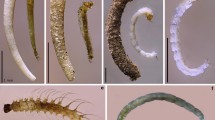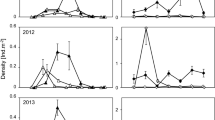Abstract
Behavioral and morphological traits often influence a key trade-off between resource acquisition and vulnerability to predation, and understanding trait differences between species can provide critical insight into their interactions with other species and their distributions. Such an approach should enhance our understanding of the criteria for coexistence between species that can interact through both competition and predation (i.e. intraguild predators and prey). I conducted a common garden experiment that revealed strong differences between three guild members (larval salamanders Ambystoma laterale, A. maculatum, and A. tigrinum) in behavior, morphology, and growth in the presence and absence of a shared top predator (the larval dragonfly Anax longipes). All three species also reduced their activity and modified their tail fin depth, tail muscle length, and body length in response to non-lethal Anax. Species that act as intraguild predators were more active and could grow faster than their intraguild prey species, but they also suffered higher mortality in laboratory predation trials with Anax. I also used survey data from natural communities to compare the distribution of Ambystoma species between ponds differing in abiotic characteristics and predatory invertebrate assemblages. An intraguild prey species (A. maculatum) was found more reliably, occurred at higher densities, and was more likely to persist late into the larval period in ponds with more diverse invertebrate predator assemblages. Taken together, these results indicate that top predators such as Anax may play an important role in influencing intraguild interactions among Ambystoma and ultimately their local distribution patterns.




Similar content being viewed by others
References
Brophy TE (1980) Food habits of sympatric larval Ambystoma tigrinum and Notophthalmus viridescens. J Herpetol 14:1–6
Caldwell JP, Thorp JH, Jervey TO (1980) Predator-prey relationships among larval dragonflies, salamanders, and frogs. Oecologia 46:285–289
Diehl S (1993) Relative consumer sizes and the strengths of direct and indirect interactions in omnivorous feeding relationships. Oikos 68:151–157
Dixon WJ (1950) Analysis of extreme values. Ann Math Stat 21:488–506
Dixon WJ (1951) Ratios involving extreme values. Ann Math Stat 22:68–78
Doherty PA, Wassersug RJ, Lee JM (1998) Mechanical properties of the tadpole tail fin. J Exp Biol 201:2691–2699
Griffiths RA, de Wijer P, May RT (1994) Predation and competition within an assemblage of larval newts (Triturus). Ecography 17:176–181
Hoff KS, Lannoo MJ, Wassersug RJ (1985) Kinematics of midwater prey capture by Ambystoma (Caudata: Ambystomatidae) larvae. Copeia 1985:247–251
Hoff KS, Huq N, King VA, Wassersug RJ (1989) The kinematics of larval salamander swimming (Ambystomatidae: Caudata). Can J Zool 67:2756–2761
Holt RD, Polis GA (1997) A theoretical framework for intraguild predation. Am Nat 149:745–764
Huey RB (1980) Sprint velocity of tadpoles (Bufo boreas) through metamorphosis. Copeia 1980:537–540
Hurd LE (1988) Consequences of divergent egg phenology to predation and coexistence in two sympatric, congeneric mantids (Orthoptera: Mantidae). Oecologia 76:549–552
Husting EL (1965) Survival and breeding structure in a population of Ambystoma maculatum. Copeia 1965:352–362
Keen WH, Travis J, Juilianna J (1984) Larval growth in three sympatric Ambystoma salamander species: species differences and the effects of temperature. Can J Zool 62:1043–1047
Kleeberger SR, Werner JK (1983) Postbreeding migration and summer movement of Ambystoma maculatum. J Herpetol 17:176–177
Kuhara N, Nakano S, Miyasaka H (1999) Interspecific competition between two stream insect grazers mediated by non-feeding predatory fish. Oikos 87:27–35
Lundqvist E, Landin J, Milberg P (2001) Diving beetle (Dytiscidae) assemblages along environmental gradients in an agricultural landscape in southeastern Sweden. Wetlands 21:48–58
Maret TJ, Collins JP (1996) Effect of prey vulnerability on population size structure of a gape-limited predator. Ecology 77:320–324
McCollum SA, Leimberger JD (1997) Predator-induced morphological changes in an amphibian: predation by dragonflies affects tadpole shape and color. Oecologia 109:615–621
Nyman S (1991) Ecological aspects of syntopic larvae of Ambystoma maculatum and the A. laterale-jeffersonianum complex in two New Jersey ponds. J Herpetol 25:505–509
Paine RT (1966) Food web complexity and species diversity. Am Nat 100:65–75
Peacor SD, Werner EE (2000) Predator effects on an assemblage of consumers through induced changes in consumer foraging behavior. Ecology 81:1998–2010
Persson L (1985) Asymmetrical competition: are larger animals competitively superior? Am Nat 126:261–266
Persson L (1991) Behavioral response to predators reverses the outcome of competition between prey species. Behav Ecol Sociobiol 28:101–105
Peters RH (1983) The ecological implications of body size. Cambridge University Press, Cambridge
Polis GA, Holt RD (1992) Intraguild predation: the dynamics of complex trophic interactions. Trends Ecol Evol 7:151–154
Polis GA, Myers CA, Holt RD (1989) The ecology and evolution of intraguild predation: potential competitors that eat each other. Annu Rev Ecol Syst 20:297–330
Power ME, Tilman D, Estes JA, Menge BA, Bond WJ, Mills LS, Daily G, Castilla JC, Lubchenco J, Paine RT (1996) Challenges in the quest for keystones. BioScience 46:609–620
Reilly SM, Lauder GV, Collins JP (1992) Performance consequences of a trophic polymorphism: feeding behavior in typical and cannibal phenotypes of Ambystoma tigrinum. Copeia 1992:672–679
Relyea RA (2001a) Morphological and behavioral plasticity of larval anurans in response to different predators. Ecology 82:523–540
Relyea RA (2001b) The relationship between predation risk and antipredator responses in larval anurans. Ecology 82:541–554
Relyea RA (2002) Competitor-induced plasticity in tadpoles: consequences, cues, and connections to predator-induced plasticity. Ecol Monogr 72:523–540
Relyea RA, Yurewicz KL (2002) Predicting community outcomes from pairwise interactions: integrating density- and trait-mediated effects. Oecologia 131:569–579
Shoop CR (1974) Yearly variation in larval survival of Ambystoma maculatum. Ecology 55:440–444
Skelly DK (1995) A behavioral trade-off and its consequences for the distribution of Pseudacris treefrog larvae. Ecology 76:150–164
Skelly DK, Werner EE, Cortwright SA (1999) Long-term distributional dynamics of a Michigan amphibian assemblage. Ecology 80:2326–2337
Smith DC, Van Buskirk J (1995) Phenotypic design, plasticity, and ecological performance in two tadpole species. Am Nat 145:211–233
Suhling F (2001) Intraguild predation, activity patterns, growth and longitudinal distribution in running water odonate larvae. Arch Hydrobiol 151:1-15
Talentino KA, Landre E (1991) Comparative development of two species of sympatric Ambystoma salamanders. J Freshw Ecol 6:395–401
Tilman D (1982) Resource competition and community structure. Princeton University Press, Princeton, NJ
Van Buskirk J (1988) Interactive effects of dragonfly predation in experimental pond communities. Ecology 69:857–867
Van Buskirk J, McCollum SA (2000) Functional mechanisms of an inducible defense in tadpoles: morphology and behavior influence mortality risk from predation. J Evol Biol 13:336–347
Van Buskirk J, Relyea RA (1998) Selection for phenotypic plasticity in Rana sylvatica tadpoles. Biol J Linn Soc 65:301–328
Van Buskirk J, Schmidt BR (2000) Predator-induced phenotypic plasticity in larval newts: trade-offs, selection, and variation in nature. Ecology 81:3009–3028
Van Buskirk J, Yurewicz KL (1998) Effects of predators on prey growth rate: relative contributions of thinning and reduced activity. Oikos 82:20–28
Van Buskirk J, McCollum SA, Werner EE (1997) Natural selection for environmentally induced phenotypes in tadpoles. Evolution 51:1983–1992
Wassersug RJ (1989) Locomotion in amphibian larvae (or, "Why aren't tadpoles built like fishes?"). Am Zool 29:65–84
Wassersug RJ, Hoff KS (1985) The kinematics of swimming in anuran larvae. J Exp Biol 119:4-30
Watkins TB (1996) Predator-mediated selection on burst swimming performance in tadpoles of the Pacific tree frog, Pseudacris regilla. Physiol Zool 69:154–167
Webb PW (1984) Body form, locomotion and foraging in aquatic vertebrates. Am Zool 24:107–120
Wellborn GA, Skelly DK, Werner EE (1996) Mechanisms creating community structure across a freshwater habitat gradient. Annu Rev Ecol Syst 27:337–363
Werner EE (1998) Ecological experiments and a research program in community ecology. In: Resetarits WJ Jr, Bernardo J (eds) Experimental ecology: issues and perspectives. Oxford University Press, New York, pp3–26
Werner EE, Anholt BR (1993) Ecological consequences of the trade-off between growth and mortality rates mediated by foraging activity. Am Nat 142:242–272
Werner EE, Anholt BR (1996) Predator-induced behavioral indirect effects: consequences to competitive interactions in anuran larvae. Ecology 77:157–169
Werner EE, Glennemeier KS (1999) Influence of forest canopy cover on the breeding pond distributions of several amphibian species. Copeia 1999:1-12
Werner EE, Peacor SD (2003) A review of trait-mediated indirect interactions in ecological communities. Ecology 84:1083–1100
Whitford WG, Vinegar A (1966) Homing, survivorship, and overwintering of larvae in spotted salamanders, Ambystoma maculatum. Copeia 1966:515–519
Wilbur HM (1972) Competition, predation, and the structure of the Ambystoma-Rana sylvatica community. Ecology 53:3-21
Wissinger SA, Sparks GB, Rouse GL, Brown WS, Steltzer H (1996) Intraguild predation and cannibalism among larvae of detritivorous caddisflies in subalpine wetlands. Ecology 77:2421–2430
Wissinger SA, Whiteman HH, Sparks GB, Rouse GL, Brown WS (1999) Foraging trade-offs along a predator-permanence gradient in subalpine wetlands. Ecology 80:2102-2116
Yurewicz KL (2002) Size structure and intraguild interactions in larval salamanders. PhD dissertation, University of Michigan
Acknowledgements
Many thanks to Neil Kubica, Brian Allan, Melissa Gonzalez, Koren Spence, and Earl Werner for help during the pond survey, to Melissa Gonzalez for assistance with the predation trials, and to Rick Relyea for advice on the common garden experiment. I am grateful to the Michigan DNR for permission to sample in the Pinckney State Recreation Area. Comments from David Allan, Deborah Goldberg, Shannon McCauley, Josh Van Buskirk, Earl Werner, and two anonymous reviewers improved this manuscript. This research was supported by grants from the University of Michigan's Department of Biology and Museum of Zoology as well as a Predoctoral Fellowship from the National Science Foundation. Animal care was within institutional guidelines.
Author information
Authors and Affiliations
Corresponding author
Rights and permissions
About this article
Cite this article
Yurewicz, K.L. A growth/mortality trade-off in larval salamanders and the coexistence of intraguild predators and prey. Oecologia 138, 102–111 (2004). https://doi.org/10.1007/s00442-003-1395-0
Received:
Accepted:
Published:
Issue Date:
DOI: https://doi.org/10.1007/s00442-003-1395-0




